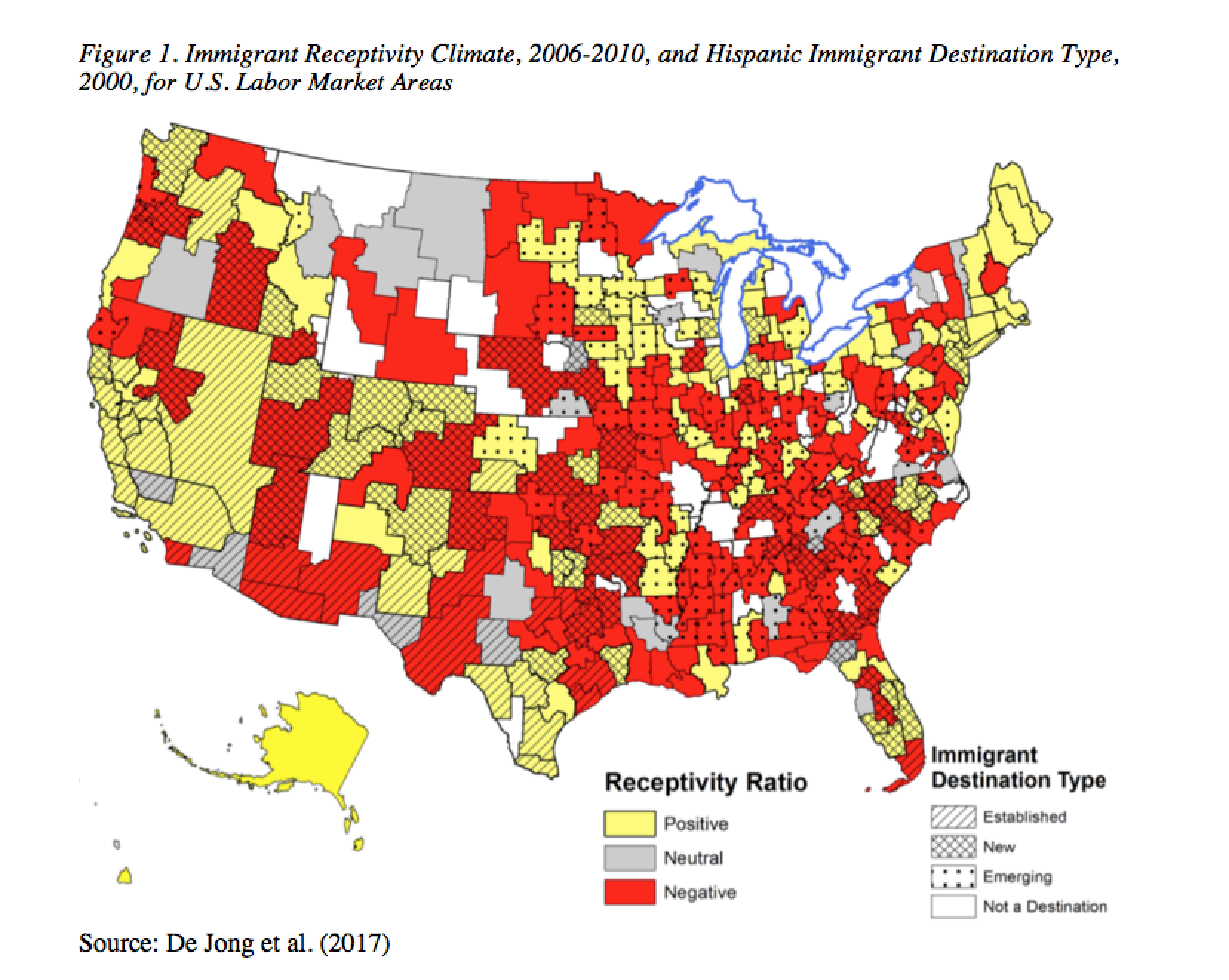Recent political events in many countries have made it clear that the receptivity of immigrants by destination area citizens is a contentious issue. Natives in arrival countries have demonstrated both hostile and welcoming attitudes and behavior
, ranging from anti-immigrant attacks and votes in elections, to spontaneous and organized food and housing support for immigrants. Cross-national studies on immigrant receptivity variation often involve public policy and national cultural identity issues. But scientific evidence on what determines within-country local area variation in immigrant receptivity climate is lacking.
Perceived race/ethnic threat theory provides a basis for explaining variation in local area immigrant receptivity climate. In this context the theory has two main components – the unemployment rate (direct job competition threat) and the size/growth of the immigrant population (competition for scarce resources or cultural hegemony) in local communities (Quillian 1995). From this perspective, native workers living in communities with high unemployment rates or in areas undergoing rapid immigrant population change will manifest more hostile attitudes toward immigrants.
Because comparable attitudinal survey data for all local areas are not available, we utilize social movements methodology to measure receptivity climate based on a content analysis of a four percent random sample of the universe of 763,967 relevant articles and stories on the topic of immigration/immigrants published/presented in all 380 U.S. labor market area newspapers and television outlets between 1995 and 2010 (De Jong et al. 2017). The logic of this methodology emphasizes coding of immigrant receptivity based on editorial opinions, letters to the editor, statements made by politicians, enacted legislation, public demonstrations, community action programs, etc. as published and seen through the local community media.
Where do immigrants encounter a more hostile or welcoming receptivity climate?
The descriptive evidence in Figure 1 shows considerable diversity across U.S. labor market areas in immigrant receptivity climate, with a more welcoming climate toward immigrants in the northeast, mid-Atlantic, some Midwest, and Pacific coast labor market areas, and a more hostile receptivity climate in southern and some mountain west labor market areas. We overlay this immigrant receptivity data with a typology of the size/growth rates for the Hispanic population. This evidence in Figure 1 shows that established historic immigrant destination areas on average demonstrated a more positive receptivity climate toward immigrants. A more negative receptivity climate is evident in “new” immigrant destinations, characterized by above national average Hispanic population size and higher growth rates, as well as in “emerging” immigrant destinations, which have a smaller but rapidly growing Hispanic population.
What explains the local area immigrant receptivity climate?
Advancing the literature, we simultaneously tested both the unemployment rate and immigrant size/growth rate components of the immigrant perceived threat theory. Using annual labor market-specific unemployment rates, decadal measures of the educational attainment of immigrants and natives in the labor market area, and theoretically relevant labor market contextual characteristics, results from our lagged regression models show that the immigrant receptivity climate is more negative where unemployment rates are higher. However, this relationship is evident only for new and non-destination areas compared with established immigrant destinations. These results suggest that in contrast to more extensive work and neighborhood native-immigrant interactions in established Hispanic destination areas, when natives in new and pre-emerging Hispanic destination areas come in contact with immigrants in an informal manner without developing in-depth interactions or friendships, they may develop suspicion and hostility which lead to higher anti-immigrant sentiments (Fetzer 2000).
We also tested the hypothesis that the impact of unemployment rates on local area immigrant receptivity is explained by the skill level of immigrants in that area. We did not find consistent support for this direct labor market competition idea.
A more important human capital impact on a positive immigrant receptivity climate is the proportion of the native population that has a college degree (Walker and Leitner 2011). A complement to the direct labor competition argument, the high education level of natives finding is largely a non-economic argument, and is consistent with Hainmueller and Hiscox’s (2007) findings that non-labor racism and cultural diversity attitudes are a major explanation for the effect of education on pro-immigrant attitudes in Europe. They conclude that more educated respondents are more likely to believe that immigration generates benefits for the host area economy.
Policy implications
Several broad social and policy implications emerge from the findings of this study. First, a decreasing (or increasing) unemployment rate in local labor market areas is associated with more (or less) favorable attitudes and behaviors toward immigrants, even if this relationship is complex. The native population receptivity attitudes may provide an important marker for successful versus unsuccessful assimilation of immigrants into the local community. Second, since a negative immigrant receptivity climate is more likely in newly emerging immigrant destination areas compared with established Hispanic immigrant destination areas, as immigrant population size/growth rates in these new areas change over time, a decline in perceived immigrant threat would be anticipated. Third, changing immigration visa preferences for more high skill immigrants, along with the secular trend toward an increasing college-educated native population in the U.S., may be dual predictors of an increasingly positive (less negative) immigrant receptivity climate for immigrants in selective labor market areas that are able to attract and retain high skill workers (Hall et al. 2011).
References
De Jong G.F., Graefe D.R., Galvan C., and Howe Hasanali S. (2017). Unemployment and immigrant receptivity climate in established and newly emerging destination areas. Population Research and Policy Review. 36(2):157-180.
Fetzer J.S. (2000). Public attitudes toward immigrants in the United States, France, and Germany. New York: Cambridge University Press.
Hainmuller J. and Hiscox M.J. (2007). Educated preferences: Explaining attitudes toward immigration iin Europe. International Organization. 61:399-442.
Hall M.S., Singer A., De Jong G.F., and Graefe D.R. (2011). The Geography of Immigrant Skills: Educational Profiles of Metropolitan Areas. Washington, DC: Brookings Institution Metropolitan Policy Program.
Quillian L. (1995). Prejudice and a response to perceived group threat: Population, composition and anti-immigrant and racial prejudice in Europe. American Sociological Review 60:586-611.
Walker K.E. and Leitner H. (2011). The variegated landscape of local immigration policies in the United States. Urban Geography. 32:156-178.



